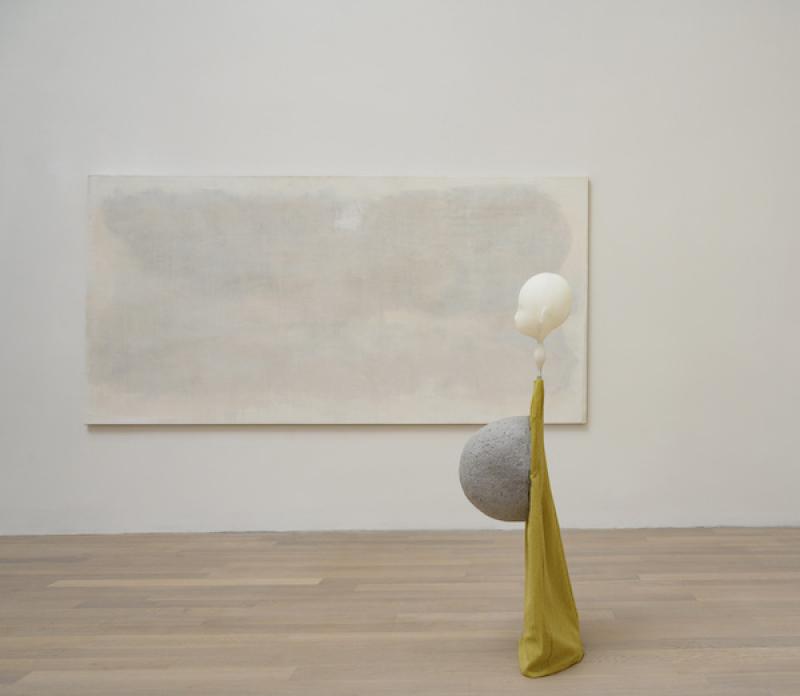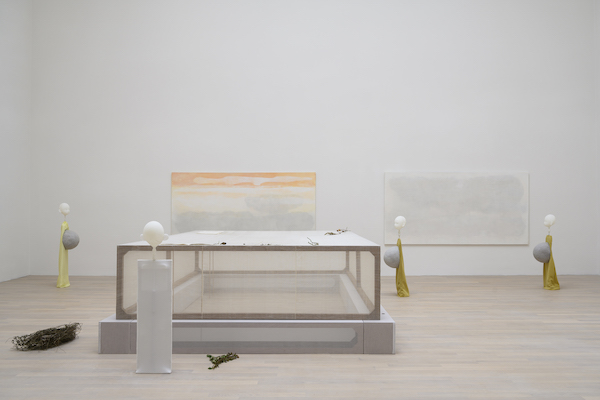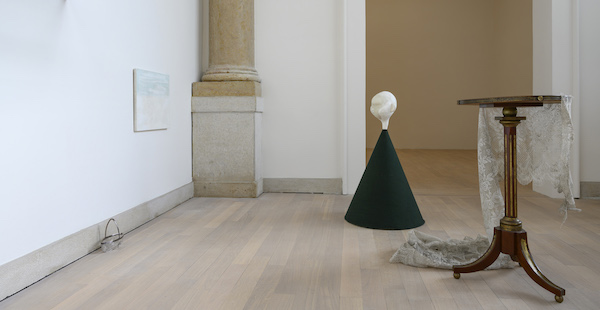Cathy Wilkes, British Pavilion, Venice Biennale review - poetic and personal | reviews, news & interviews
Cathy Wilkes, British Pavilion, Venice Biennale review - poetic and personal
Cathy Wilkes, British Pavilion, Venice Biennale review - poetic and personal
Deeply personal sculptural installation muses on different generations of women and passing time

Dried flowers like offerings lie atop a gauze-covered rectangular frame. Pebbles surround its base alongside plaster casts, a desiccated dragonfly and an animal foot charm. Their placement is purposeful; their exact significance unclear. Four rib-high figures with moon faces, sausage string necks and wafer-thin bodies face the frame. Three wear golden gowns like devotees or disciples; all bear pendulous, darkly bellying stomachs before them over their clothes.
Through six “creations” across six rooms, Wilkes places objects including porcelain plates, ripped lace, otherworldly human figures and grimed towels into staged arrangements that imply a kind of modular narrative. An air of melancholy suffuses the show – or the sense of time held in stasis like the memory of a lost home. Aside from a short text by Wilkes in the catalogue, little information is provided. Certain concerns are more pronounced however, with the exhibition touching on themes including motherhood, tedium, obsolescence and loss.
The mental and physical preoccupations of motherhood come to the fore in the third room. A central figure stands on awkwardly curled toes, her green dress pinned with tiny photographs of an Eastern European boy furiously eating soup. At her feet, two amputated hands pack up grimed towels – the fear of dirt and hunger which might assail a child are set against the relentless, immolating cycle of laundry and cleaning.
In this context, a mother is both guardian and servant to her child, but the following rooms offer a different perspective. With one wall made entirely of glass, claustrophobia eases, breath and perspective return. A child figure on the right balances a painting on the left. Between the two are glass objects and the sense is of mother and child having attained a fragile peace. Two paintings hang on perpendicular walls in the next room suggesting equality and common understanding – taken together these rooms suggest the extent of pain and sacrifice necessary to attaining mutual respect between mother and child.
However, Wilkes discourages merely sequential readings. She refers in the catalogue to quantum entanglement – whereby “An atom here among us and another atom in a far away galaxy are inseparable epitomes of the same”, which feels somehow like a comment on the distance between women of different generations – and plays with visitors’ experience of space, allowing chance happenings to intrude. The pavilion’s entrance is its exit, so to leave involves retracing the exhibition – a passage laden with implications of undoing and rewriting, doubling and repeating. And by eschewing artificial illumination in favour of subtly modulated skylights she opens up the exhibition daylight, to the diurnal and seasonal cycles. Scudding clouds and flashes of sun change the appearance of each room from moment to moment – visual shifts imply emotional ones, both equally out of control.
While the exhibition plays with opposed concepts, Wilkes refrains from placing them into conflict, instead preferring to counterpoint or overlay them. “I […] am every atom unfolding from the womb,” she writes, simultaneously conjuring a child and a cancer, both of which “nucleate”. The frame’s gauze in the first room could be a shroud or a baby’s muslin comforter, or even both – it recurs in smaller form in the sixth room; the blue tint of the pavilion’s custom-laid floor brings out the grain of the wood, simultaneously exposing its growth and evoking dead driftwood abraded by tides. Development and destruction, memory and movement are held in balance throughout.
Like poetry, each item in Wilkes’s installation is important; ritual appears to have attended their placement. By refraining from speaking explicitly about her work she invites viewers to draw their own conclusions; through this, with care and attention, a deeply personal work becomes moving to many more. Not everyone will fall for this year’s pavilion, but in the frenetic heart of the Biennale, Wilkes’s work rewards attention and commands a slower pace.
- Cathy Wilkes' British Pavilion is commissioned by the British Council and is at the 58th Venice Biennale until 24 November
- Read more visual arts on theartsdesk
rating
Share this article
The future of Arts Journalism
You can stop theartsdesk.com closing!
We urgently need financing to survive. Our fundraising drive has thus far raised £49,000 but we need to reach £100,000 or we will be forced to close. Please contribute here: https://gofund.me/c3f6033d
And if you can forward this information to anyone who might assist, we’d be grateful.

Subscribe to theartsdesk.com
Thank you for continuing to read our work on theartsdesk.com. For unlimited access to every article in its entirety, including our archive of more than 15,000 pieces, we're asking for £5 per month or £40 per year. We feel it's a very good deal, and hope you do too.
To take a subscription now simply click here.
And if you're looking for that extra gift for a friend or family member, why not treat them to a theartsdesk.com gift subscription?
more Visual arts
 'We are bowled over!' Thank you for your messages of love and support
Much-appreciated words of commendation from readers and the cultural community
'We are bowled over!' Thank you for your messages of love and support
Much-appreciated words of commendation from readers and the cultural community
 Sir Brian Clarke (1953-2025) - a personal tribute
Remembering an artist with a gift for the transcendent
Sir Brian Clarke (1953-2025) - a personal tribute
Remembering an artist with a gift for the transcendent
 Emily Kam Kngwarray, Tate Modern review - glimpses of another world
Pictures that are an affirmation of belonging
Emily Kam Kngwarray, Tate Modern review - glimpses of another world
Pictures that are an affirmation of belonging
 Kiefer / Van Gogh, Royal Academy review - a pairing of opposites
Small scale intensity meets large scale melodrama
Kiefer / Van Gogh, Royal Academy review - a pairing of opposites
Small scale intensity meets large scale melodrama
 Jenny Saville: The Anatomy of Painting, National Portrait Gallery review - a protégé losing her way
A brilliant painter in search of a worthwhile subject
Jenny Saville: The Anatomy of Painting, National Portrait Gallery review - a protégé losing her way
A brilliant painter in search of a worthwhile subject
 Abstract Erotic, Courtauld Gallery review - sculpture that is sensuous, funny and subversive
Testing the boundaries of good taste, and winning
Abstract Erotic, Courtauld Gallery review - sculpture that is sensuous, funny and subversive
Testing the boundaries of good taste, and winning
 Edward Burra, Tate Britain review - watercolour made mainstream
Social satire with a nasty bite
Edward Burra, Tate Britain review - watercolour made mainstream
Social satire with a nasty bite
 Ithell Colquhoun, Tate Britain review - revelations of a weird and wonderful world
Emanations from the unconscious
Ithell Colquhoun, Tate Britain review - revelations of a weird and wonderful world
Emanations from the unconscious
 Rachel Jones: Gated Canyons, Dulwich Picture Gallery review - teeth with a real bite
Mouths have never looked so good
Rachel Jones: Gated Canyons, Dulwich Picture Gallery review - teeth with a real bite
Mouths have never looked so good
 Yoshitomo Nara, Hayward Gallery review - sickeningly cute kids
How to make millions out of kitsch
Yoshitomo Nara, Hayward Gallery review - sickeningly cute kids
How to make millions out of kitsch
 Hamad Butt: Apprehensions, Whitechapel Gallery review - cool, calm and potentially lethal
The YBA who didn’t have time to become a household name
Hamad Butt: Apprehensions, Whitechapel Gallery review - cool, calm and potentially lethal
The YBA who didn’t have time to become a household name

Add comment